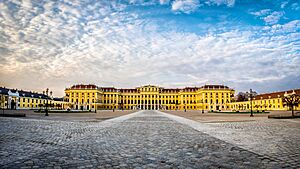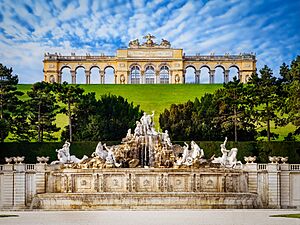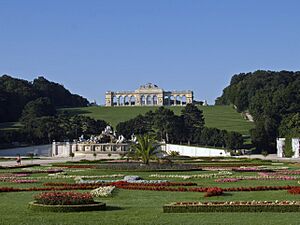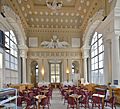Schönbrunn Palace facts for kids
Quick facts for kids Schönbrunn Palace |
|
|---|---|
|
Schloss Schönbrunn
|
|
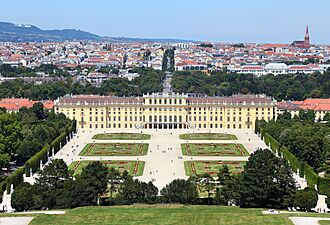
Schönbrunn Palace in 2022
|
|
| General information | |
| Location | Hietzing, Vienna, Austria |
| Coordinates | 48°11′04″N 16°18′43″E / 48.184516°N 16.311865°E |
| UNESCO World Heritage Site | |
| Official name | Palace and Gardens of Schönbrunn |
| Criteria | Cultural: i, iv |
| Inscription | 1996 (20th Session) |
| Area | 160 ha (400 acres) |
Schönbrunn Palace is a famous palace in Vienna, Austria. It used to be the main summer home for the Habsburg rulers, who were powerful emperors and empresses. The name Schönbrunn means "beautiful spring." This name comes from a natural spring that provided water for the palace.
This huge palace has 1,441 rooms and is built in the Baroque style. It is one of Austria's most important historical and cultural places. The palace and its large gardens have a history of over 300 years. They show how the tastes of the Habsburg rulers changed over time. Since the 1950s, Schönbrunn Palace has been a very popular place for tourists to visit.
Contents
History of Schönbrunn Palace
The story of Schönbrunn Palace began in 1569. That year, Holy Roman Emperor Maximilian II bought a large area of land. This land was next to the Wien river. There was already a house on the land called Katterburg.
The emperor had the area fenced off. He brought in animals like pheasants, ducks, deer, and wild boars. This made it a perfect hunting ground for the royal family. They also kept "exotic" birds like turkeys and peacocks in a special part of the area. Fishponds were also built.
For the next 100 years, the area was used for hunting and fun. Eleonora Gonzaga, who loved hunting, spent a lot of time there. She received the land as her home after her husband, Ferdinand II, died. Between 1638 and 1643, she added a palace to the Katterburg house. The name "Schönbrunn" was first used in 1642.
The palace you see today was mostly built and changed during the 1740s and 1750s. This was when Empress Maria Theresa ruled. She received the estate as a wedding gift. Later, Franz I had the outside of the palace redecorated. This gave it the neoclassical style it has today.
Franz Joseph was the longest-reigning Emperor of Austria. He was born at Schönbrunn and lived there for most of his life. He passed away there in 1916 when he was 86 years old. After the Habsburg monarchy ended in 1918, the palace became property of the new Austrian Republic. It was then turned into a museum.
During World War II, parts of the palace were bombed in 1945. After the war, from 1945 to 1955, the palace was used by the British military. They had offices there during the Allied Occupation of Austria. When Austria became a republic again in 1955, the palace went back to being a museum. It is still used for important events. For example, U.S. President John F. Kennedy and Soviet premier Nikita Khrushchev met there in 1961.
Since 1992, a special company owned by Austria has managed the palace and gardens. This company takes care of keeping the palace in good condition. In 1996, UNESCO added Schönbrunn Palace and its gardens to the World Heritage List. They recognized it as an amazing example of Baroque art and architecture.
Exploring the Gardens
The large, sculpted garden area in front of the palace is called the Great Parterre. In 1695, a garden designer named Jean Trehet planned this beautiful French garden.
The palace grounds also have many other cool features. These include the Tiergarten, which is a zoo built around 1755. There is also an orangerie, which is a special greenhouse for citrus trees. A large palm house was built in 1882.
The area west of the palace was turned into a play and training ground for the Habsburg children in the 1800s. It was common then for young princes to learn military skills in parks. A small building that was used as a shelter there is now a café. It is called Landtmann's Jausen Station.
At the far western edge of the gardens, there is a botanical garden. This garden was redesigned in 1828. That is when the Old Palm House was built.
Gloriette
The main path through the garden leads to a hill. On top of this hill, since 1775, stands the Gloriette structure.
Empress Maria Theresa wanted the Gloriette to show the power of the Habsburg family. She ordered builders to use "otherwise useless stone" from another palace that was being taken down.
Roman Ruin
The Roman Ruin was designed by architect Johann Ferdinand Hetzendorf von Hohenberg. It was built in 1778. It was first called the Ruin of Carthage.
In the 1700s, it became popular to build fake ruins in gardens. These ruins were called follies. They were meant to look like ancient buildings falling apart. This showed how great empires could decline. The Roman Ruin at Schönbrunn looks like an old building slowly crumbling. It has a rectangular pool and a large arch with walls.
Activities at Schönbrunn Today
Schönbrunn is Vienna's most popular place to visit. In 2017, about 3.8 million people visited the palace. The whole Schönbrunn area, including the zoo, the Palm House, and the concerts, had over five million visitors in 2009.
You can buy tickets online for tours of the palace. Besides tours, you can also enjoy many classical concerts. These concerts feature music by Mozart and other famous composers. They are held in the beautiful halls, the Orangerie, or the Schlosstheater.
The yearly Summer Night Concert Schönbrunn is also held in the Schönbrunn gardens.
Schönbrunn Palace Concerts
The Schönbrunn Palace Concerts are performed by the Schönbrunn Palace Orchestra. This orchestra was started in 1997. It has been led by Maestro Guido Mancusi since 1998. He also started the Chamber Opera Schönbrunn.
In Vienna, the orchestra performs daily concerts. They play at the same place where Mozart and Salieri had a famous music contest in 1786. The orchestra often tours around the world.
Film and Television Productions
The gardens and palace have been used as a setting for many movies and TV shows. These include the Sissi movies from the 1950s. It was also seen briefly in the James Bond movie The Living Daylights. The comedy The Great Race was filmed there in 1965. Jackie Chan also filmed scenes for Armour of God on the grounds.
The Austrian TV series, Kommissar Rex, has filmed several episodes there. In an episode of Kuroshitsuji, a character mentions being a guest at Schönbrunn Palace parties. Dutch violinist André Rieu and the Johann Strauss Orchestra used the palace as a backdrop for a version of the European Anthem in 2003.
The palace has also been featured in the reality show The Amazing Race 4. In one challenge, a team had to carry trays of champagne glasses across a ballroom. In another season, The Amazing Race 23, teams had to race through the garden's maze to find the finish line at the Gloriette.
The Schönbrunn Palace Silver Coin
Schönbrunn Palace was chosen to be on a special silver coin. This coin is the Austrian 10-euro The Palace of Schönbrunn silver coin. It was made on October 8, 2003. One side of the coin shows the front of the palace behind a large fountain.
See also
 In Spanish: Palacio de Schönbrunn para niños
In Spanish: Palacio de Schönbrunn para niños
- Imperial Carriage Museum
- Chinese Cabinets in Schönbrunn Palace
- Tiergarten Schönbrunn, the zoo in the palace gardens that claims to be the oldest one in the world
- Gloriette
- List of Baroque residences
- List of World Heritage Sites in Austria
Images for kids
-
Soviet troops in the Schönbrunn Palace gardens, 1945


